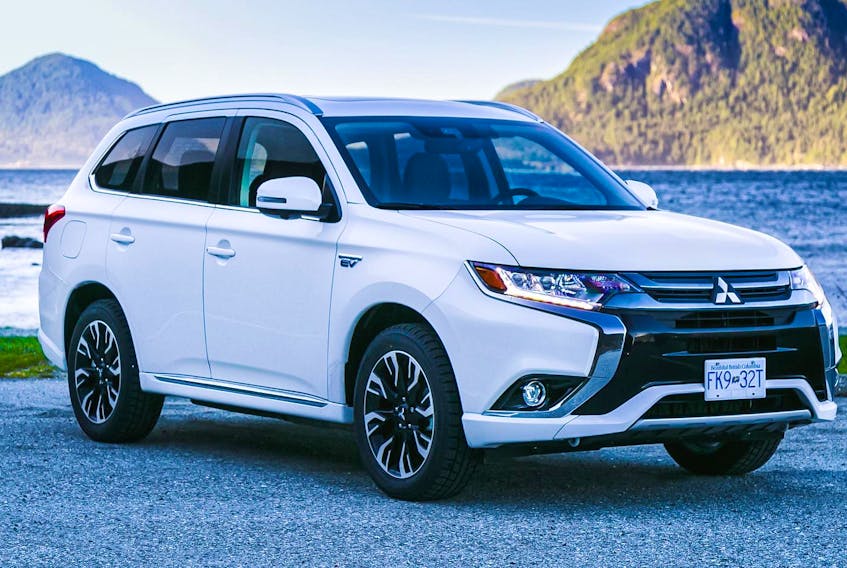Every fall, a technology-minded panel from the Automobile Journalists Association of Canada gets together to take a look at the latest in automotive technology.
We take a look at safety, green and innovative technologies to select the best of the best. One of the nominated entries this year is the hybrid powertrain in Mitsubishi’s Outlander PHEV (plug-in hybrid electric vehicle).
The Outlander PHEV has proven to be very popular, with more than 5,000 sold in 2018, making it Canada’s best-selling plug-in-hybrid SUV.
The volume of these sales not only impact Mitsubishi but the automotive segment as a whole as more and more drivers are introduced to PHEV technology.
As a hybrid vehicle, the Outlander can operate in EV, Series or Hybrid modes. In EV mode the vehicle is powered by the two electric motors, one to drive the front wheels and one to drive the rear wheels, providing all wheel drive in electric mode.
In Series mode, the gasoline engine recharges the battery and the battery provides electric power to the electric motors to drive the wheels.
In Parallel mode, both the electric motors and gas engine power the vehicle, with the gasoline engine driving the front wheels and the electric motors supplementing the power as needed. The gasoline engine is coupled to the drivetrain with a wet clutch (running in oil) and the engagement is almost imperceptible, making for very smooth operation.
As a plug-in vehicle, the 12 kilowatt hour, 300 volt lithium-ion battery pack, which is located beneath the floor of the vehicle, can be charged by plugging the vehicle into either 110 volt household power with the cord that comes with the vehicle.
Charging to full charge can take eight to 13 hours depending on current flow from the 110 volt circuit.
Level 2 220-volt charging stations, which can be installed in the home or for commercial use, will charge the battery pack in 3.5 hours, while the Level 3 high-current public charging stations take only 25 to 30 minutes to recharge the battery.
In operation, the Outlander always starts in EV (electric vehicle) mode even if the dashboard battery charge indicator shows low.
There is a reserve maintained in the battery that isn’t indicated on the gauge to allow for this feature.
The SUV can operate on just electric power up to 120 kilometres per hour and the range on electric power is indicated on the dash display.
Maximum EV mode range with a full charge is 35 kilometres although my driving experience in the Outlander shows this can be extended using regenerative braking to recharge the battery.
The driver of the Outlander PHEV has a lot of control over how the vehicle operates.
A button on the console lets the driver select EV mode so the vehicle operates on electric mode as a priority and the gasoline engine doesn’t engage till the throttle is pressed to 75 per cent travel.
Battery charge mode can also be selected so the gasoline engine is used to charge the battery and power the vehicle, conserving electrical energy in the battery.
Using this mode, I found that I could recharge the battery to provide approximately one kilometre of electrical operation for every kilometre I drove in battery charge mode.
The driver also has control of regenerative braking. The paddle shifters behind the steering wheel don’t select gears — instead they select one of six levels of regenerative braking from B0 to B5.
The vehicle defaults to Level 2 regenerative braking on start up and every time the vehicle decelerates, both electric motors become generators to recharge the battery.
B5 is the most aggressive level of regenerative braking and it feels like the brakes have been applied when you lift off the accelerator.
In B5 mode, the brake lights are automatically turned on every time it goes into regenerative mode.
By selecting different modes, the driver can optimize battery regenerative braking to the driving terrain.
I found using a higher level worked well on hilly terrain to maximize the vehicle electrical range.
With a 10-year warranty on powertrain and battery, 1,500-pound towing capacity and efficient use of space that provides no loss of cargo space, the Outlander PHEV has proven very popular.
More drivers with more experience in PHEVs is changing the way people perceive driving on electricity, making the Outlander a game changer in the marketplace.
Jim Kerr is a master automobile mechanic and teaches automotive technology.









